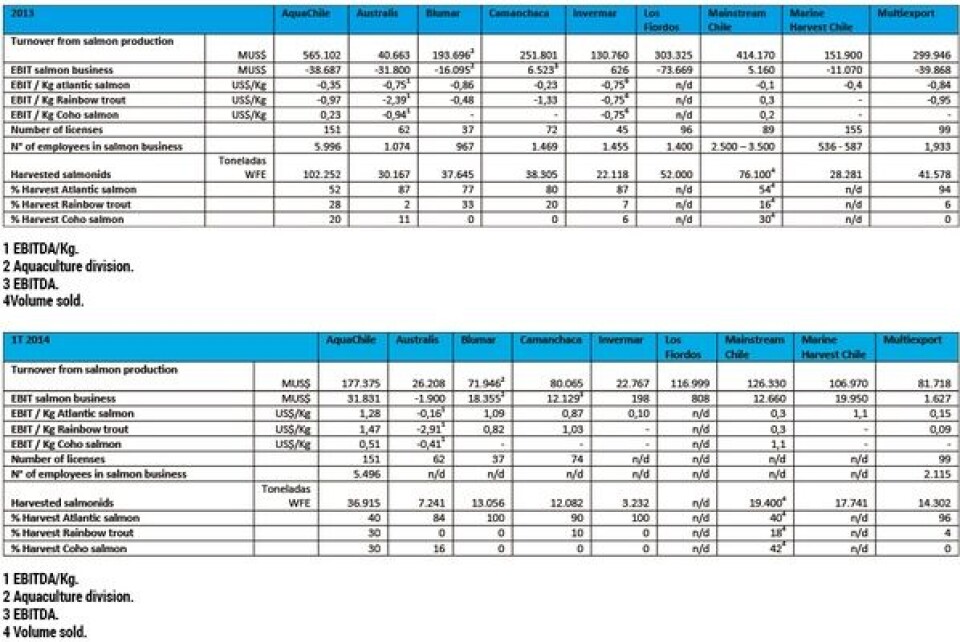Positive results in first quarter A Good Start
By Christian Perez Mallea

Nine salmon producing companies operating in our country submit quarterly reports to their local authorities. AquaChile, Australis Seafoods, Blumar, Camanchaca, Invermar, Los Fiordos and Multiexport do so in Chile while Cermaq and Marine Harvest submit in Norway. Through the figures and comments presented in the Q1 2014 reports of those firms, it is possible to identify the most significant factors of the recovery experienced by the Chilean salmon industry in recent seasons. There was both an improvement in the sanitary conditions as well as a recovery of production in the years 2010 and 2011 after the so called ‘ISA crisis’. A significant increase in biomass between 2011 and 2012 was followed by a sanitary/production decline in 2012 and 2013. These factors finally began to stabilize and results from the last months of 2013 started improving. In addition, the above mentioned period was also marked by substantial fluctuations in the average price paid for salmonids in different markets, mainly due to the greater or lesser availability and supply exported by the local industry each season.
Better performance Last year began with a sharp rise in the number of sea lice per fish. In February, March and April 2013, each week brought a new all-time high record. Concomitantly, the mortality rates for Atlantic salmon and trout were significantly higher during the entire first half of last year. According to information from the benchmarking programme run by SGS, the industry-wide percentage of monthly losses for Atlantic salmon exceeded 1.76 per cent in March and April 2013. In addition, the average harvest weights as well as the Kg produced per smolt fell. By the fourth quarter of 2013, all the above indicators began to improve. AquaChile claims that part of the sanitary and production improvements observed were due to lower levels of sea lice infections “which had been driven down by collaborative industry actions to deal with this parasite including the coordinated use of delousing treatments in large geographical areas and the coordinated rotation of delousing agents as well as improvements in the treatment practices.” claims Along the same lines, Marine Harvest underscored the importance of the permission granted to use the active ingredient Azamethiphos in Chile last year (Salmosan, Bayer), “this has temporarily relived some of the pressure on biology”. Regarding the biological aspect, Salmones Multiexport emphasized that the improvement in the sanitary conditions as well as a recovery of production is continuing in their company and the Chilean industry. This is illustrated by the reduced monthly mortality rate of Atlantic salmon in the first quarter of this year, which reached 0.9 per cent for the local industry and 0.6 per cent in Multiexport. Meanwhile, Cermaq said the general sanitary conditions in Chile, although still challenging, are improving... “The main reason for their concern is the presence of SRS at some Atlantic salmon and trout sites.”

Lower costs As a result of the challenging production scenario and increased losses experienced by the industry last year, a significant decline in productivity and ex-cage costs was also observed. According to Blumar, its ex-cage production cost for Atlantic salmon increased from US$ 3.3/kg by the end of 2012 to US$ 4.4/kg early last year. This indicator has gradually been declining from quarter to quarter, falling to US$ 4.0/kg by the end of 2013 and recording US$ 3.8/kg in the first three months of this year. For Marine Harvest, the decrease has been from US$ 4.9 in the first quarter of 2013 to US$ 4.7 in the same period this year. In turn, Cermaq explained that a better average harvested weight and the close monitoring of sanitary conditions have allowed them to reduce their ex-cage costs by 5 per cent for Atlantic salmon in the first quarter of 2014, compared to the previous quarter.
Great prices and curbed supply When comparing the average prices of salmonids in the first quarter of 2013 and the same period of this year, several of these companies reported an increase that exceeded 40 per cent. According to Australis Seafoods, the main reason for the price increase was a more moderate growth in supply from Chile and Norway. Cermaq expressed a similar opinion, although the latter company put more emphasis on the high prices reached by the species Coho salmon and Rainbow trout.
In the same vein, AquaChile reported price increases of 40 %, 70 % and 44 % for Atlantic salmon, trout and Coho salmon respectively between the first quarter of 2013 and the same period this year. Complementing this, Multiexport showed in its Q1 2014 presentation that the local salmon industry growth is averaging out pending future regulatory changes and industry consolidation. As an example of this scenario, the company reported a close to 12 % decrease in the stocking of salmonid species in our country between 2012 and 2013, from 280 million to 247 million smolts. However, Multiexport reported a slight increase projected for this year up to 251 million smolts. Both percentages are well below the nearly 5-6 % annual increase in global demand, according to several analysts. Finally, this decreased growth, along with the enhanced production and sanitary performance would indicate a significant improvement in productivity and profitability for the entire industry in the short term. However, the lower prices obtained by some local shipments due to degradation or loss of quality caused by sanitary issues -in particular because of SRS, remains a matter of concern.






















































